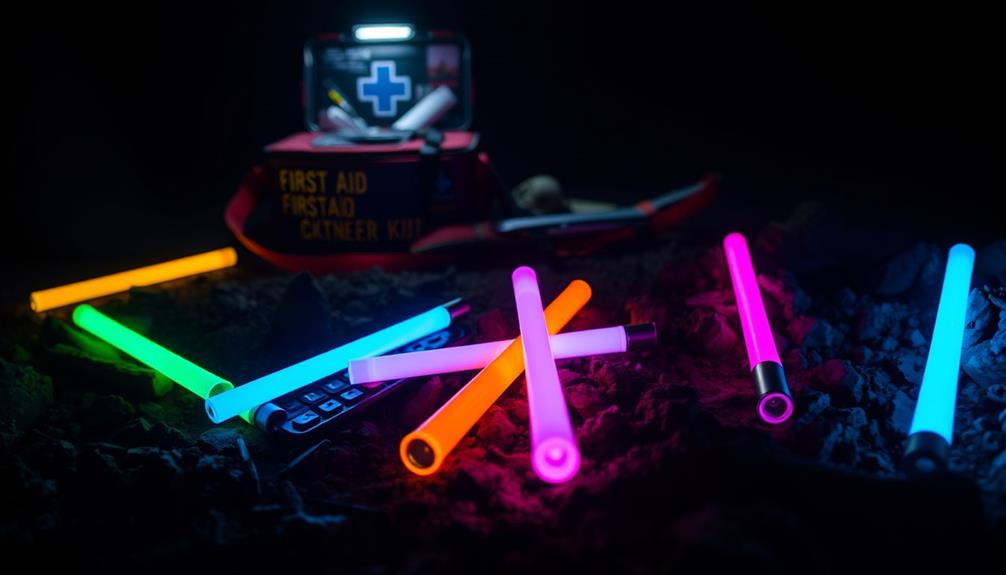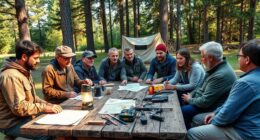When phones are down, it's essential to have a reliable communication plan in place. Start by designating meeting points so everyone knows where to go during emergencies. Consider using alternative tools like ham radios, satellite phones, or two-way radios to stay in touch. Low-tech methods, like leaving written messages or using visual signals, are also effective. Practice these strategies regularly to guarantee everyone feels confident. Engage with your local community for support and develop connections that can help during crises. Discover more ways to enhance your communication plan and guarantee family safety during emergencies.
Key Takeaways
- Establish designated meeting points for family members to gather during emergencies when phones are unavailable.
- Utilize alternative communication tools like ham radios, satellite phones, or two-way radios for reliable contact.
- Leave clear written messages in visible locations to guide loved ones during crises.
- Engage with local support networks and participate in community preparedness workshops for enhanced communication strategies.
Importance of Communication Planning
Effective communication planning is important during emergencies, as it helps you stay connected with loved ones when traditional phone networks fail. By establishing designated meeting points in advance, you can greatly reduce confusion and anxiety during a crisis. Make certain every family member knows where to go and how to contact each other.
It's essential to utilize multiple communication tools, like satellite phones or ham radios, to enhance your chances of reaching loved ones when conventional methods aren't available. Regularly reviewing and updating your communication plan according to changes in family dynamics or locations is fundamental to maintain its effectiveness.
Don't forget to practice your communication plan; drills or discussions guarantee everyone is familiar with the steps they need to take during an emergency. This preparation not only builds confidence but also allows your family to execute the plan efficiently when it counts.
Alternative Communication Methods

When traditional communication methods fail, exploring alternative communication methods can keep you connected with loved ones during emergencies.
One effective option is ham radios, which require a license but allow for long-distance communication without relying on cell towers. If you're in an area lacking cellular coverage, consider satellite phones. Though they can be pricey, they provide global connectivity via orbiting satellites.
For short-range communication, two-way radios like walkie-talkies are excellent. They don't need power or cell networks, making them reliable in emergencies. You can also learn Morse code; this classic skill enables you to send essential messages using light or sound signals, bypassing technology completely.
In addition to these tools, signal mirrors can help you signal for help over long distances by reflecting sunlight. They're versatile, as they can also assist in starting fires if needed.
Utilizing these alternative communication methods guarantees that you stay in touch with your loved ones, no matter the circumstances. Preparing with these emergency communication tools can truly make a difference when you need to connect.
Written Communication Strategies

Written communication strategies can play an essential role in emergencies, ensuring you convey important messages even when electronic devices fail. By leaving clear notes or messages in visible locations, you can guide family members to designated meeting points or provide vital updates on the situation.
Using alternative writing methods, like carving messages into wood or arranging stones to form letters, can also be effective for signaling when traditional materials aren't available. Establishing a system for written communication, such as prearranged signals or codes, enhances clarity and reduces confusion during crises.
Here's a helpful table summarizing key written communication strategies:
| Strategy | Purpose | Example |
|---|---|---|
| Clear Notes | Convey important information | Leaving a note with meeting point details |
| Signaling | Communicate without traditional materials | Carving messages on nearby trees |
| Prearranged Signals | Enhance clarity and understanding | Using specific symbols to indicate safety |
Utilizing Ham Radios

Ham radios provide a reliable communication alternative that can keep you connected during emergencies when traditional networks are unavailable. These powerful communication tools allow you to communicate with others over long distances without relying on the power grid or conventional infrastructure.
To operate a ham radio, you'll need an FCC license, which involves passing an exam, but the investment is worth it for the extensive capabilities it offers during a crisis. With a basic setup costing around $200, you can easily establish a connection with local and global operators, especially crucial during natural disasters.
Regular practice is essential; becoming familiar with your equipment and emergency protocols can greatly enhance your readiness to respond effectively when emergencies strike.
Ham radios also serve as a community resource, connecting you with local clubs and emergency response teams. This collaboration can streamline communication efforts during disasters, ensuring you and your loved ones remain informed and safe.
Investing time in learning how to use ham radios can make all the difference when you need to reach out and stay connected.
Emergency Meeting Points

When phones are down, knowing where to meet can be a lifesaver.
You should establish designated gathering locations that everyone in your family can easily reach.
Make certain to communicate these plans clearly and practice them regularly to guarantee everyone's on the same page.
Designated Gathering Locations
Establishing designated gathering locations in advance helps guarantee your family knows where to meet during emergencies when communication is down. Choose spots that are easily accessible, like local parks or community centers, ensuring everyone can find them on foot or by bike. Familiarity with these locations is vital, especially during a crisis.
Consider potential obstacles, such as road closures or natural barriers, and identify alternative locations in case your primary meeting point becomes unreachable. Regularly review these designated gathering locations and practice your plan to keep it fresh in everyone's mind. Family discussions about this process can enhance understanding and commitment to the plan.
Encourage your loved ones to stick to the meeting points, even if it takes time for everyone to arrive. Patience is essential during emergencies; you may not all reach the location at the same time. By discussing the importance of these gathering spots, you reinforce the value of communication and teamwork in challenging situations.
With proper preparation, your family will be ready to reunite and support each other, no matter what happens.
Clear Communication Plans
Creating clear communication plans that include emergency meeting points helps guarantee everyone knows where to go during a crisis.
Start by establishing designated emergency meeting points that all family members can easily access. Make certain everyone knows their locations and how to reach them. Regularly review and update your communication plan to reflect changes in family dynamics, locations, or contact information.
Incorporate alternative communication methods like walkie-talkies or ham radios to maintain contact when phones are down. Discuss these options with your family to guarantee they understand how to use them effectively.
Practicing your communication plan through drills is essential; it allows everyone to familiarize themselves with the routes and procedures before an emergency.
When choosing meeting points, prioritize accessibility and safety. Consider potential obstacles, such as blocked roads or unsafe areas, that could hinder travel during an emergency.
Community Engagement for Support

Building a local support network is key to staying connected when phones are down.
You can tap into local ham radio networks and participate in community preparedness workshops to strengthen your communication skills and resources.
Engaging with your neighbors and local groups not only boosts your readiness but also fosters a sense of community during tough times.
Local Ham Radio Networks
Local ham radio networks serve as a lifeline for communities, ensuring effective communication when traditional phone systems fail. These networks consist of licensed ham radio operators who come together to provide essential emergency communication and support. Engaging with local ham radio clubs can greatly enhance community resilience, fostering strong connections among members.
Here are some benefits of participating in local ham radio networks:
- Communication Check-Ins: Regularly scheduled nets allow ham radio operators to practice skills and stay updated on community needs.
- Emergency Communication Resources: Licensed operators often provide training sessions, helping you learn about radio operation and how to respond during crises.
Community Preparedness Workshops
Participating in community preparedness workshops equips you with essential skills to communicate effectively during emergencies, complementing the support offered by local ham radio networks. These workshops teach you various communication methods, including the use of satellite phones and ham radios, ensuring you're ready when traditional systems fail.
In these community workshops, you'll engage in hands-on training with essential communication devices, making you familiar with their operation. You'll also learn low-tech signaling techniques like Morse code and signal mirrors, broadening your skill set for emergency communication.
By joining these workshops, you'll foster collaboration and resource-sharing among neighbors, establishing local networks that enhance your community's resilience during crises. Regular sessions allow families to discuss and refine their emergency communication plans, meeting points, and backup strategies.
Furthermore, staying informed about local emergency services and available resources through these workshops improves your ability to respond swiftly in a disaster.
Don't underestimate the power of community; by participating, you're not just preparing yourself, but also helping to create a strong support network for everyone in your area.
Short-range Communication Tools

When phones are down, using short-range communication tools can help you stay connected and coordinate effectively with loved ones. These devices don't rely on cellular networks, making them essential in emergencies. Here are some options to take into account: 1. Walkie-talkies offer a reliable way to communicate within a limited range, making them useful for outdoor activities or in settings where cell signal may be weak.
2. Other options include Bluetooth devices and personal locator beacons, which can be used for both communication and safety purposes.
3. In addition to short-range communication tools, it’s also important to consider and implement home security strategies to protect your loved ones and property. This can include measures such as installing alarms, using smart locks, and implementing a neighborhood watch program.
- Walkie-talkies: They offer a reliable way to communicate over distances up to 30 miles, depending on the model and terrain.
- FRS and GMRS radios: FRS radios don't require a license and work well for short distances, while GMRS radios need a $70 license but can reach up to 30 miles with the right settings.
Additionally, you might want to take into account devices like the goTenna, which allows you to send text messages and GPS locations through a personal mesh network.
Long-range Communication Options

When traditional communication methods fail, long-range options can keep you connected.
You'll want to explore satellite phones for their reliability, ham radios for emergency situations, and CB radios for local chatter.
Each tool has its advantages, so let's break down what you need to know.
Satellite Phone Advantages
Satellite phones offer a reliable way to communicate over long distances, especially in remote areas where traditional cell service isn't available. These devices connect directly to orbiting satellites, providing global coverage that's essential during emergency situations or natural disasters when local networks might fail.
Here are some advantages of using satellite phones:
- Dependable Communication: You can make voice calls and send text messages even in the most isolated locations.
- Operational During Crises: Unlike regular phones, satellite phones remain functional when terrestrial networks are overwhelmed.
While satellite phones can be an investment—from about $600 to $2,000—they're invaluable for maintaining contact with loved ones during critical times.
Keep in mind that ongoing usage fees vary based on your network and call destination, but the peace of mind they provide is often worth the cost.
Whether you're on an expedition or facing a sudden disaster, satellite phones guarantee you stay connected when it matters most.
Ham Radio Essentials
Ham radios serve as an essential tool for long-range communication, especially in emergencies where traditional networks are unavailable. To operate a ham radio, you'll need an FCC license, which requires passing a knowledge-based test. This preparation is critical, as it equips you with the understanding necessary for effective communication during crises.
These radios allow you to communicate over long distances without relying on cell towers, making them indispensable in emergencies. Ham radios operate on various frequency bands, with VHF and UHF commonly used for local communication. For global reach, HF bands are your best bet, connecting you with distant stations.
A basic ham radio setup can cost around $200, but investing in advanced systems may run into the thousands. Regular practice with your equipment is crucial, ensuring you're familiar with your radio's operation and capabilities.
It's also important to know local emergency frequencies, as this knowledge enhances your ability to communicate effectively when it matters most. By mastering ham radios, you're setting yourself up for reliable emergency communication, allowing you to stay connected with loved ones when it counts.
CB Radio Basics
CB radios provide a straightforward and accessible way to maintain communication over moderate distances, making them a practical choice for both personal and emergency use. Operating on 40 shared channels within the 27 MHz band, you can achieve short-range communication typically spanning 5-20 miles, depending on terrain and antenna quality. Best of all, there's no special licensing required to get started!
Here are a few key points to reflect on:
- Mobile units can enhance range and signal quality when installed in vehicles.
- Handheld units serve as effective backups, giving you flexibility in communication.
Popular brands like Cobra, Galaxy, Uniden, and Midland offer options ranging from $100 to $120 for both handheld and mobile units.
By choosing the right equipment and understanding how to use it, you can guarantee that you stay connected with your loved ones, even when phones are down.
Whether you're out on the road or at home, CB radios make it easy to keep communication lines open in any situation.
Historical Lessons Learned

Historical events highlight how vital it's to have a communication plan in place when traditional means fail during crises.
Take the 2003 Cedar Wildfire and the 2011 Southwest blackout, for example; many families lost touch during these widespread crises. Learning from these situations, you should consider alternative communication methods.
During World War II, ham radios played a significant role in maintaining contact when communication infrastructure collapsed.
The Great San Francisco Earthquake of 1906 also showed the effectiveness of visual signaling, as survivors used smoke signals and flags to convey their needs amidst the chaos.
In the aftermath of Hurricane Katrina in 2005, the failure of cellular networks highlighted the importance of tools like satellite phones and two-way radios for coordinating rescue efforts.
You can also rely on written messages, such as leaving notes or using messengers, which have served people well during emergencies throughout history.
By understanding these historical lessons, you can better prepare yourself and your loved ones for communicating effectively when the unexpected happens.
Embrace these proven strategies to guarantee you're ready to connect in times of crisis.
Current Threats to Communication

As technology advances, the threats to communication systems have evolved, posing new challenges during emergencies that you need to be aware of. Recent warnings from U.S. agencies highlight rising cyber threats targeting critical infrastructure, potentially disrupting communication when you need it most.
Consider these key points:
- Satellite phones may seem reliable, but outdated encryption can leave them vulnerable to exploitation.
- During natural disasters, terrestrial mobile networks often overload, making traditional phones useless and pushing you towards alternatives like ham radios.
Understanding these threats is essential. You can't always rely on conventional telecommunications, especially when legal restrictions around satellite phone usage may hinder your options in certain regions.
Diversifying your communication tools and being prepared with alternatives like ham radios or satellite phones can help guarantee you stay connected, even when disaster strikes. Equip yourself with knowledge and resources, and you'll be better prepared to reach loved ones when traditional methods fail.
Conclusion
When phones go down, staying connected with loved ones is essential.
By planning ahead and exploring alternative communication methods, you can bridge the gap and keep your relationships strong.
Whether it's through written notes, ham radios, or setting up emergency meeting points, your creativity can turn chaos into harmony.
Remember, effective communication isn't just a lifeline; it's like a superpower that can conquer any challenge.
So stay prepared, and you'll always find a way to connect!










